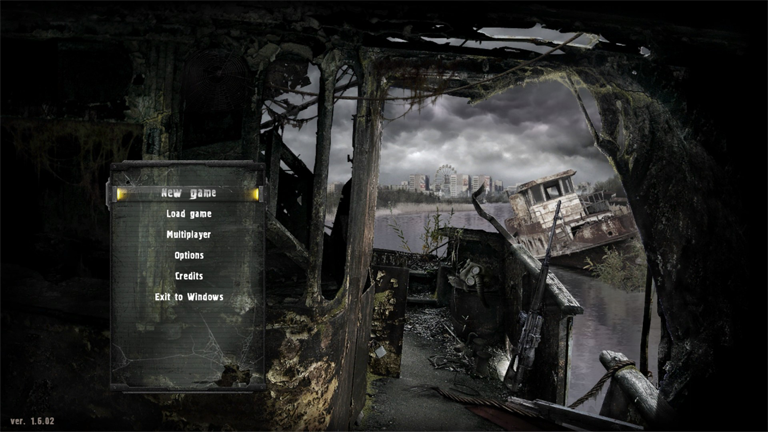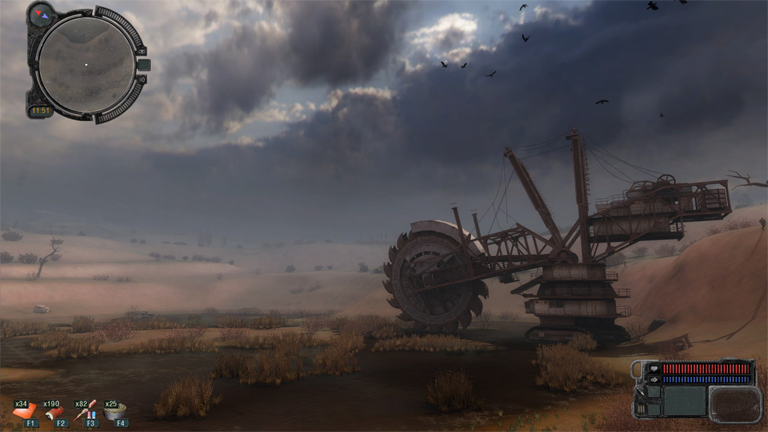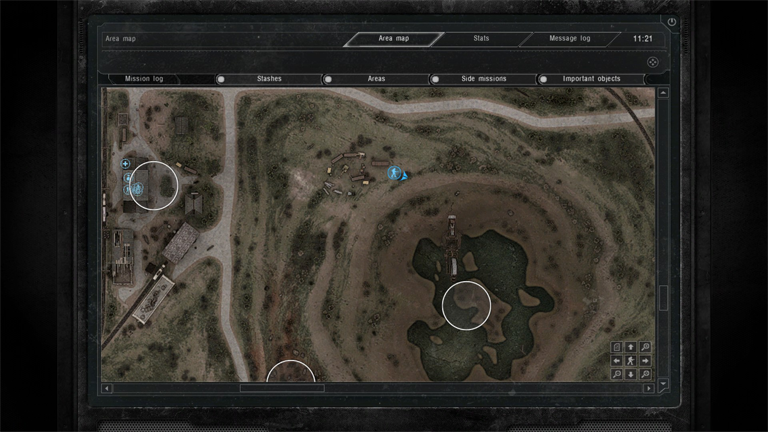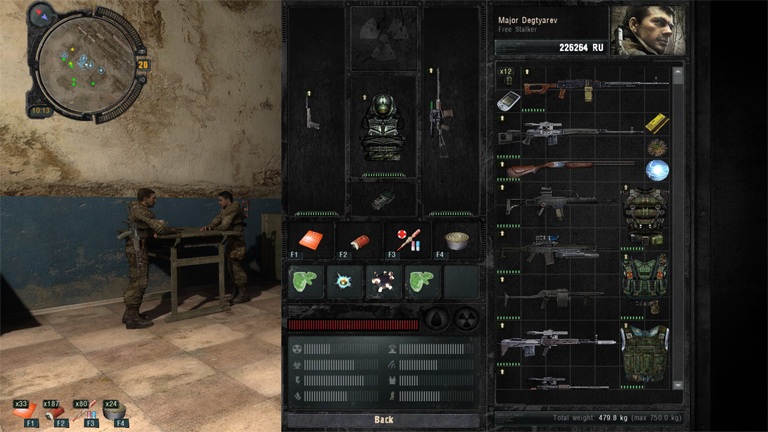To start at the beginning, GSC Game World's S.T.A.L.K.E.R. games are a partial distillation of the 1972 novel called Roadside Picnic by Arkady and Boris Strugatsky (which Andrei Tarkovsky adapted into his award-winning Stalker movie in '79). In the novel, aliens visited earth and altered the very laws of physics at their landing sites, which became known as "Zones."
As nobody understood how the Zones functioned (but most things in 'em were lethal), they were cordoned off by the United Nations, to be investigated solely by scientists. But once it became known that some things in the Zones were not only safe but actually beneficial (like small metal rings that, once spun, could keep spinning forever) a black market arose to meet demand for such artifacts. And supplying said market were stalkers: poor schmucks with no training or safety gear and only their wits and luck to rely on, who snuck into the Zones and brought artifacts out for sale.
Out of the rich, ingenious source material of one of my all-time favorite novels, GSC Game World kept the Zone (kinda), stalkers (sorta), anomalies and artifacts. They then changed the Zone's origin (which was now a man-made side-effect of the Chornobyl disaster), made other parts of the lore "fit", gave all stalkers guns and – presto! – the first S.T.A.L.K.E.R. game was born (with periods in the title alluding to a dumb backronym).
To be frank, I get mixed feelings whenever I play a S.T.A.L.K.E.R. title. On the one trotter, I'm still peeved that the best a studio could do with such a lovingly-crafted, rich story was an FPS; while, on the other – what can I say? – I kind of like creeping around the Zone, gun-in-hoof, exploring abandoned military installations, battling mutants and collecting shiny doodads...

Call of Pripyat, the third game in the series, follows up on the events of the original (2007's Shadow of Chornobyl) which, honestly, were kinda meh (as, indeed, are the main plots of all three S.T.A.L.K.E.R. games) and not really worth delving into. Suffice it to say that, because of the first game's ending, egress into the Zone seems easier than ever, which the Ukrainian military exploits by sending in five recon helicopters to map the area. Things Go Wrong, contact with the helicopters is lost, and a lone SBU (Ukrainian intelligence) agent – Major Alexander Degtyarev (whom you control) – is sent in to see what happened.
In terms of writing, Pripyat is simply adequate. Outside of being a skilled stalker and soldier, Degtyarev is a blank slate (which is actually good, in a way, allowing the player to mold his decision-making to their preference); while Zone inhabitants (brought to you by the letter 'S'), are comprised entirely of Scientists, Soldiers or Stalkers, voiced appropriately and only rarely exhibiting an actual Glimmer of Individuality.

The side missions you can undertake are actually more interesting than the main plot (which isn't bad, exactly, but plods along with all the energy of a tired commuter going home from work); and your interactions with the factions inhabiting the three areas of the Zone (Zaton, Jupiter and Pripyat) are what gives the game most of its mood and personality.
Speaking of factions, technically Pripyat has nine, but only seven of 'em offer actual interaction (with Monolith and Zombies providing a different spin on "enemies").
Bandits, as the name implies, are out for themselves and prey on others. Loners are stalkers who operate individually. Scientists try to make sense of the Zone, with Mercenaries making sure they can do so unhindered. Duty and Freedom are two sides of the same coin dealing with Zone access: Duty thinks the Zone should be kept off-limits; while Freedom, predictably, thinks Doody is full of crap. Lastly, the Military are mostly remnants of the recon flights you were sent to discover.

The three game areas are fairly large and liberally sprinkled with points of interest, secret caches of equipment and roaming packs of mutants or zombies. Each has a safe area with merchants and storage, where you can trade, modify weapons or pick up new missions (such as the beached Skadovsk freighter in Zaton or Yanov Station in Jupiter).
While missions will often take you to interesting spots, the fun thing about Pripyat is that the entirety of the Zone is worked up to the same level of detail and exploring places on your own can be just as fulfilling as going where you're told to. With the ever-present danger of anomalies, emissions (world-shaking psychic events that kill anyone out of doors and drop flocks of dead birds in their wake); zombies, mutants and even other, less community-minded stalkers, around every corner, every outing – no matter how brief – offers a frisson of excitement (or, as we pigs like to call it — spine-tingling fear).
To control the amount of excitement in your immediate vicinity, Call of Pripyat offers a robust selection of 37 Excitement-Suppressors (read: guns), which range from pistols and submachine guns to shotguns, rifles and grenade launchers. Any weapon can be modified to increase a particular aspect (such as ammo capacity, rate of fire, damage or accuracy) and some even come in unique, named variants much better than base spec.

Rounding out the gameplay elements are Pripyat's survival mechanics (such as bleeding or radiation damage or armor and weapons that degrade and have to be repaired); and Zone artifacts (which boost statistics but at the cost of constant radiation exposure). That aside, Call of Pripyat plays like any run-of-the-mill FPS with the added bonus of being able to continue exploring the Zone indefinitely once you finish the main plot.
While it might not live up to the lofty standard of its source material, S.T.A.L.K.E.R.: Call of Pripyat is the best offering of the series and a fun game in its own right: a shooter with alternative lore and a tense atmosphere that lets you snoop around industrial ruins and abandoned military bases to your heart's content. If you like urban decay, post-soviet architecture, secret government projects or simply exploration (and – shooting), Call of Pripyat will see you right... Just don't play it expecting more than an FPS with a plot: competent or not, high art this ain't.
Recommended Mods:
-
-as I am not a fan of survival mechanics, I play my Call of Pripyat with two mods that raise the carry weight and stop weapon/armor degradation; both used to be on Nexus mods (as "Carry More Weight + SEVA suit with Night Vision Mod" and "No Weapon Degrade/100% Perfect Dropped Weapons Mod");
-
-Gunslinger Mod (which is still in Beta despite being in development for yonks) breathes new life into the game by fully animating all weapon and equipment interactions in first person; it might not sound like a big deal, but once you see what a difference seeing a clip being loaded or pills being taken makes for the overall presentation, Gunslinger'll be a fairly easy sell;
Pig Recommends:
-
-for (at least in the West) an obscure little novel, Roadside Picnic sure made big waves; and if you feel like seeing more of the ripples, try Metro 2033 (which was made by a studio staffed with former GSC Game World devs and influenced by the Strugatskys' book) or The Final Station (games); Otherside Picnic, Darker than Black and Heavenly Delusion (anime) all contain elements from the book, with Otherside Picnic being the closest parallel, while the other two merely contain similar ideas (such as inexplicable "zones" where normal physical laws do not apply); of the three, DTB and Delusion are very good (in that order), while Otherside is simply watchable;
-
-checking out S.T.A.L.K.E.R. 2: Heart of Chornobyl once it comes out in Q1 of 2024; I can't guess how good it will be, but – sucker for an underdog that I am – after disputes, a studio closure, that West Games hoopla, 14 years in limbo and GSC having to relocate to Prague because of the Russian invasion of Ukraine, I'm just happy it'll finally get made;
